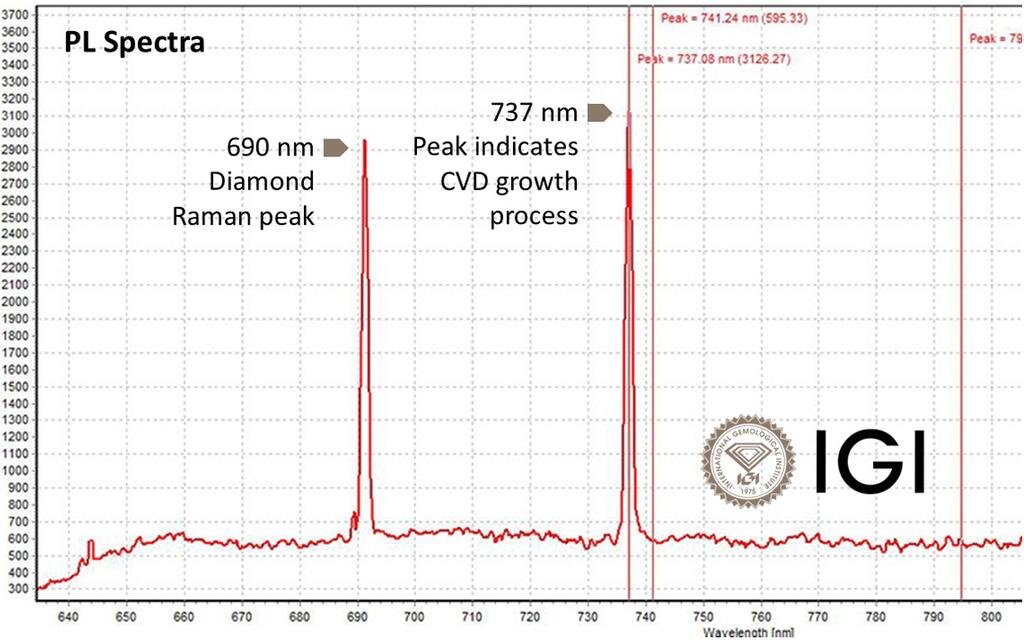IGI Detects 6-Carat Lab-Grown Diamond With Fake Inscription
The pear-cut stone was engraved with a GIA report number for a natural diamond of the same size and shape.

The 6.01-carat, pear-shaped synthetic diamond was fraudulently inscribed with the Gemological Institute of America report number for a G-color natural diamond of the same size and shape, but with a few key differences, IGI said in a news release issued Tuesday.
First, the lab said, photoluminescence (PL) spectroscopy, which is now widely used by grading labs to separate natural diamonds from lab-grown stones and to identify diamond treatments, shows a wavelength peak of 737 nanometers in the diamond (see chart below).
This is an indicator that the diamond was grown in a factory using the chemical vapor deposition process.

Second, when examined under a microscope, IGI graders saw a carbon inclusion where the feather was indicated on the clarity plotting diagram in the GIA report.
They also noticed a cloud inclusion, resulting in IGI giving the lab-grown diamond a lower clarity grade than VVS1, the clarity grade of the natural diamond.
Lastly, there was a discrepancy between the depth of the diamond IGI examined and the depth noted on the GIA report.
“Everyone in our industry must be vigilant,” said IGI CEO Tehmasp Printer, who took over as head of the lab in October after Roland Lorie retired.
“As attempted fraud increases, the need for ongoing verification is a necessary step to protect consumers from purchasing misrepresented gems and jewelry.”
The news from IGI comes on the heels of a story from Rapaport about Italian grading lab Gem-Tech finding three lab-grown diamonds inscribed with GIA report numbers for natural diamonds.
According to the report, those diamonds were accompanied by physical grading reports stating they were natural diamonds.
However, like the 6.01-carat lab-grown diamond examined by IGI, the stones Gem-Tech examined displayed characteristics normally only seen in diamonds grown using the CVD process.
Also like IGI graders, the Gem-Tech graders noticed the three submitted stones were slightly different than the diamonds described in the grading reports.
GIA issued a news release about fraudulent inscriptions back in May 2021 following a string of incidents earlier that year, including the submission of three moissanites engraved with report numbers for natural diamonds and the submission of a mix of lab-grown diamonds and treated natural diamonds engraved with fraudulent report numbers.
In that release, Tom Moses, GIA executive vice president and chief laboratory and research officer, said, “This unfortunate situation demonstrates why it is important, especially in any transaction where the buyer does not have a trusted relationship with the seller, to have the diamond grading report updated before completing a purchase.”
GIA said it has seen “several” lab-grown diamonds with counterfeit inscriptions referencing GIA diamond grading reports for natural diamonds.
These lab-grown diamonds have measurements and weights that are almost identical to the GIA reports but the differences are “significant enough to raise concerns.”
The Latest

Executive Chairman Richard Baker will take over the role as rumors swirl that a bankruptcy filing is imminent for the troubled retailer.

Mohr had just retired in June after more than two decades as Couture’s retailer liaison.

Shekhar Shah of Real Gems Inc. will serve as president of the Indian Diamond & Colorstone Association in 2026.

How Jewelers of America’s 20 Under 40 are leading to ensure a brighter future for the jewelry industry.

This year’s good luck charm features the mythical horse Pegasus, and is our first Piece of the Week of the new year.


Articles about crime, engagement rings, and a necklace worn in the World Series generated the most interest among readers.

As part of the leadership transition, Sherry Smith will take on the role of vice president of coaching strategy and development.

Roseco’s 704-page catalog showcases new lab-grown diamonds, findings, tools & more—available in print or interactive digital editions.

It marks the third time the country has headed the Kimberley Process. Ghana will serve as vice chair.

The new Bulova x Stetson designs highlight two animals often associated with the American West—the bison and the Texas Longhorn.

Its residency at Yamron Jewelers will run through May 2026.

From influential executives to innovative designers, we pay tribute to the people we said goodbye to this year.

The retailer is expanding into areas with large Indian and South Asian populations.

The Italian brand has opened its first flagship amid the peaks of the Dolomites in Madonna di Campiglio, Italy.

The new curation at the Natural History Museum of Los Angeles County showcases rare gem and mineral specimens in their uncut, natural state.

The couple pleaded guilty to concealing at least $127 million in cash transactions at its precious metals businesses.

Consumers shared concerns about prices, inflation, tariffs, trade, and politics in the survey’s write-in response section.

In February 2026, the auction house will move its headquarters to the former Steinway Hall, a neoclassical landmark on Billionaires’ Row.

The new show will take place Jan. 23-25, 2026.

The former BHP Billiton leader and Gemfields chairman is remembered for his influential leadership throughout his 50-year mining career.

The LVMH-owned brand has partnered with the costume design union to revamp its award for 2026.

The luxury titan inked a deal to acquire an initial minority stake in the jewelry manufacturer with a pathway to full ownership by 2032.

The company’s curation of unsigned vintage and estate jewelry debuted at the Bloomingdale’s in Costa Mesa, California.

In the recent multi-shipment seizure, CBP also found counterfeit Audemars Piguet, Moncler, and Chrome Hearts items.

Helzberg’s Chief Retail Officer Mitch Maggart shared details about its tests of a new store concept rooted in an elevated luxury experience.

Jewelers of America execs and National Jeweler editors discuss tariffs, the sky-high gold price, and the engagement that broke the internet.

The luxury goods company said founder Ippolita Rostagno will remain at the brand’s helm.


























